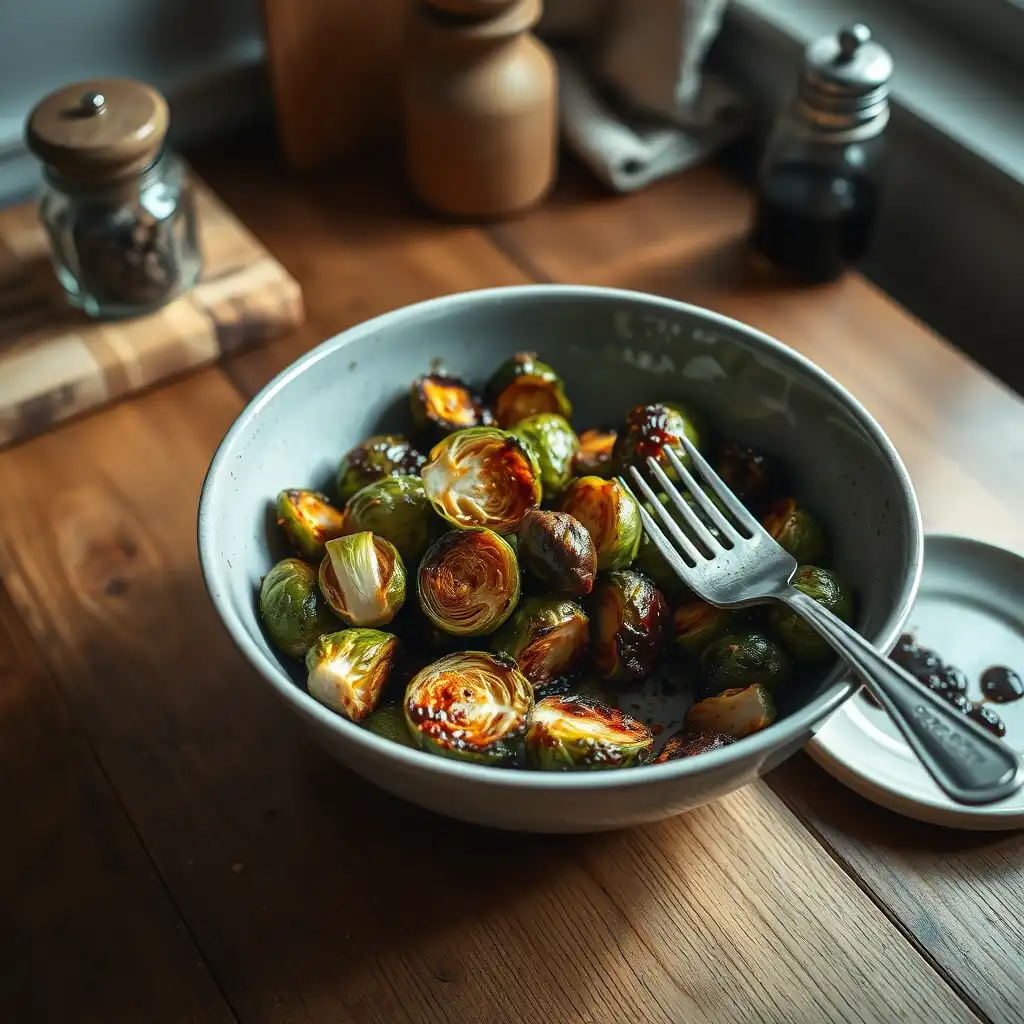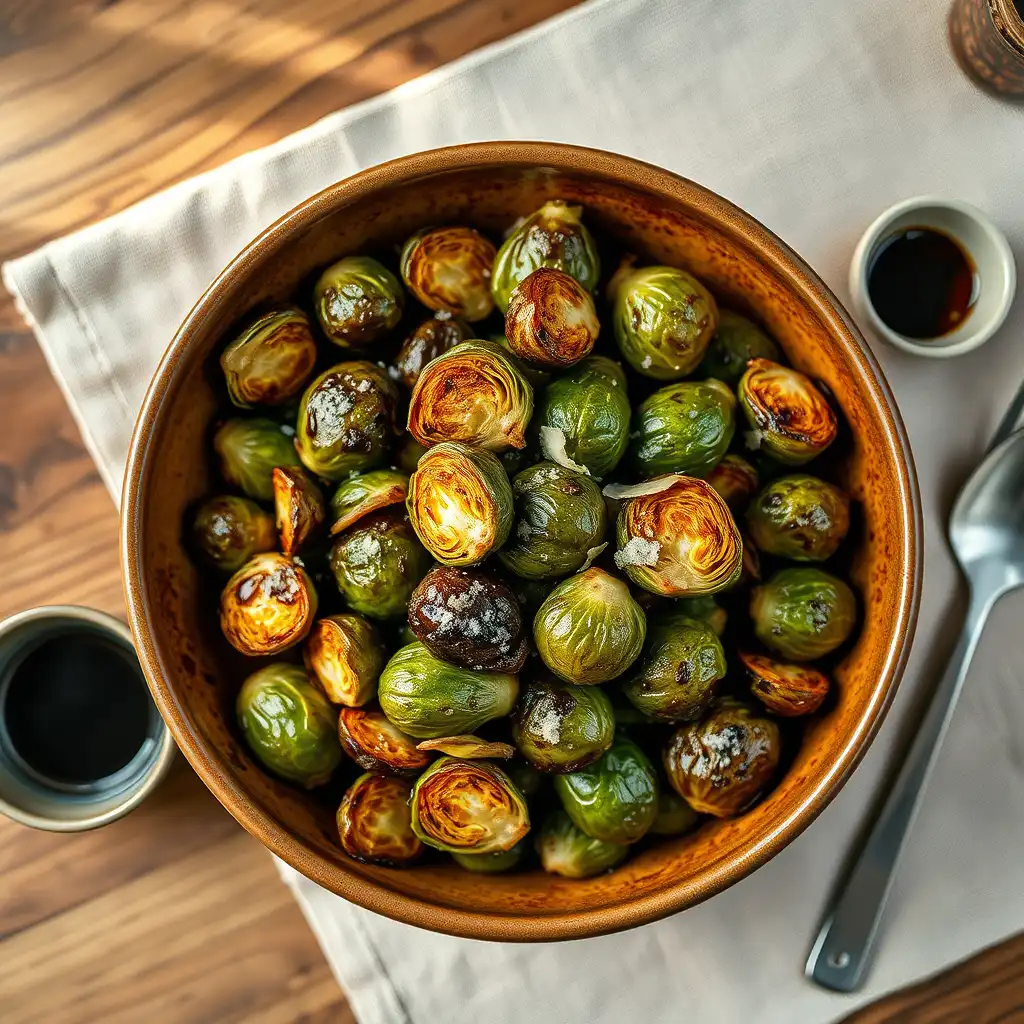There’s a moment—right before the sprouts hit the hot pan—when everything feels too simple. Brussels sprouts, a drizzle of something sweet, some oil, some salt. But then, something magic happens in that oven. It’s not just roasting. It’s alchemy. I once watched a skeptical line cook eat one off the tray and immediately whisper, damn. That’s what this recipe does. It makes believers out of haters.
Balsamic Roasted Brussels Sprouts isn’t your average side dish. It’s smoky, caramelized, sweet, tangy, with crisped edges that crunch like potato chips and insides so tender they collapse under a fork. This recipe isn’t just about Brussels sprouts. It’s about coaxing flavor outta stubborn vegetables until they sing like roasted candy.
What makes it special? Two things: proper caramelization and a reduction of balsamic that sticks like a glaze without turning syrupy or cloying. There’s also the fact that you don’t steam ’em first. No mush here. Only blistered goodness, every leaf a crisp bite.

Ingredients & Substitutions
This isn’t a complicated recipe. It’s just honest food that needs to be treated right.
- 1½ lbs fresh Brussels sprouts, trimmed and halved.
→ Don’t use frozen. They’ll steam, not roast. If they’re yellowing or mushy at the stem, skip ‘em. - 3 tablespoons olive oil, extra virgin if you’ve got it.
→ Avocado oil works too. But avoid anything too grassy like walnut oil—it burns fast. - 1 tablespoon good-quality balsamic vinegar
→ Spend the extra buck. Cheap balsamic = acidic water. You want that thick, rich kind that coats a spoon. - 1½ teaspoons kosher salt
→ Fine sea salt is okay, but go easy—it spreads faster. - ½ teaspoon freshly cracked black pepper
→ Don’t use pre-ground unless you absolutely have to. It’s basically dust. - 1 teaspoon maple syrup or honey (optional)
→ Want a bit of sticky-sweet finish? Add it in the last 5 minutes of roasting.
Optional Add-Ins (professional moves):
- 1 tablespoon Dijon mustard for a zippy glaze
- Crumbled bacon for extra depth
- Toasted hazelnuts or almonds for crunch
- Parmesan cheese post-roast, for umami magic
Substitutions for dietary or regional needs:
- Vegan? Use maple syrup instead of honey.
- No balsamic? Sherry vinegar + a tiny spoon of brown sugar will do.
- Low-FODMAP? Swap Brussels sprouts for chopped green beans or zucchini. It’s not the same, but it roasts beautifully.
Step-by-Step Instructions
Prep the sprouts
First things first—trim the dry ends off the sprouts. If the outer leaves fall off, save them. They crisp up like chips. Slice the sprouts in half, lengthwise. Don’t cut them randomly. Lengthwise exposes the flat side that gets all that golden char.
Toss with oil, salt, pepper
In a big bowl—don’t skimp on the size—toss the halved sprouts with olive oil, salt, and pepper. Make sure every surface is glossy. If you see dry bits, add more oil.
Expert tip: Warm the oil just a little before tossing. Not hot, just barely warm—it coats better and helps with even caramelization.
Arrange flat-side down
This step’s crucial. Lay them cut-side down on a parchment-lined baking sheet. They need space. If they’re touching, they’ll steam. Use two pans if needed. Crowding kills the crisp.
Roast at high heat
Roast in a 425°F (220°C) oven for about 20–25 minutes. Don’t touch them. Seriously. Resist the urge to flip halfway. The untouched side gets all the char.
At 20 minutes, check. The bottoms should be deep brown, nearly black in spots. That’s where the flavor lives.
Add balsamic & sweetener
Once they’re roasted, toss them quickly with balsamic vinegar. If you’re using maple or honey, drizzle it in now too. Toss in the still-hot pan to help it stick and coat.
Pro tip: Don’t add the balsamic before roasting—it’ll burn and turn bitter. Always finish with it.
Optional final roast (2–3 minutes)
For an even stickier glaze, return them to the oven for just a couple of minutes after tossing in the balsamic. Watch closely—it goes from caramel to carbon real fast.
Cooking Techniques & Science
Why high heat?
Brussels sprouts are packed with natural sugars. High heat breaks those down into complex caramel notes. Go too low, and they just steam in their own juices.
Why cut-side down?
That cut surface acts like a skillet. It sears in contact with the hot pan, building the Maillard reaction—those delicious browning flavors.
Why balsamic after roasting?
Acid + sugar = browning catastrophe in a hot oven. You’ll get acrid, burnt notes instead of a rich, glossy glaze. Think of balsamic as your final varnish.
Roasting Tool Talk:
Use heavy-duty sheet pans. Thin ones warp and unevenly heat. And skip the silicone mat here. You want the sprouts to kiss the hot metal.
Avoid This Mistake:
Overcrowding. Always. This is where people mess up. It’s not just aesthetics. Overcrowded pans steam the veggies and make ’em soggy. Think dry heat + airflow = crispy.
Cultural Note:
Though a humble veg, Brussels sprouts have roots in Belgian cuisine—dating back to the 13th century. But the roasting revolution? That’s all modern Western kitchens. Once we learned to char instead of boil ’em, everything changed.
Serving & Pairing Suggestions
These aren’t just a side. They’re a statement. Serve them warm, piled high in a shallow ceramic bowl so the char is on full display.
Meal Pairings:
- With roast chicken or duck: The tangy-sweet glaze complements rich poultry.
- Tossed into warm grain salads: Especially with farro or wild rice, pomegranate, and feta.
- Topped with a poached egg: Breakfast-for-dinner genius.
- With sharp cheeses: Think blue cheese crumbles or aged gouda.
Drinks:
- A dry white wine like Sauvignon Blanc or a light Pinot Noir.
- A Belgian-style beer—slightly funky, yeasty, malty. They were born to hang with sprouts.
- Sparkling water with lemon and a crack of black pepper. Weird, but incredible palate cleanser.
Conclusion
Balsamic Roasted Brussels Sprouts aren’t just about taste—they’re about transformation. From bitter little orbs to sticky, crispy jewels of flavor. All it takes is heat, acid, and a bit of courage to leave them be while they roast.
Remember the keys: cut ’em right, space ’em out, don’t flip too early, and always balsamic at the end. Once you’ve nailed it once, you’ll never steam a sprout again. This isn’t garnish. This is the main act.
One last tip?
Keep those crispy outer leaves that fall off. Roast them alongside. Chef’s snack. Don’t tell anyone.
FAQs
Can I make balsamic roasted Brussels sprouts ahead of time?
Yes—but don’t toss them in balsamic until you’re ready to serve. Reheat in a hot oven for 5–7 minutes to re-crisp. Microwave = sog city.
What’s the best way to cut Brussels sprouts for roasting?
Always trim the stem and slice lengthwise. Keep similar sizes together so they cook evenly. Tiny ones can stay whole if needed.
Why are my Brussels sprouts soggy instead of crispy?
Too close together on the pan. Crowding traps moisture. Also, check your oven temp—it needs to be hot enough (425°F minimum).
Can I use frozen Brussels sprouts?
Nope. Don’t even try. They’re water-logged and made for steaming, not roasting. Use fresh, always.
How do I make them spicy?
Add a pinch of red chili flakes or a drizzle of chili crisp after roasting. Even a spoon of harissa stirred into the balsamic does wonders.

Olivia P. is a seasoned food blogger at Tastywink, sharing delicious, easy-to-follow recipes inspired by him passion for home cooking. With years of culinary blogging experience, he brings flavor, creativity, and a personal touch to every dish.
